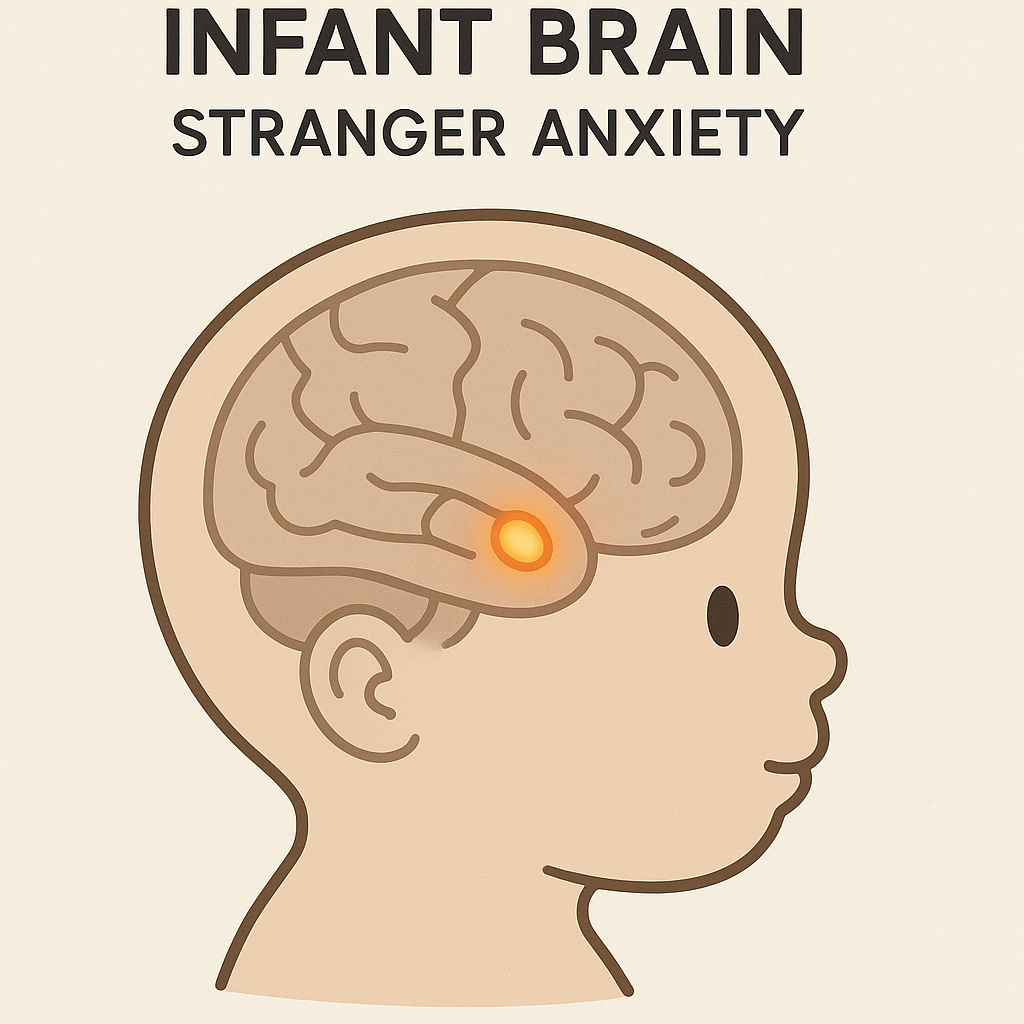By 12 months, most babies—around 4 out of 5—will cry or cling when a new face appears, signaling their “stranger danger” instinct kicking in. See Stranger Anxiety overview on Wikipedia. While these sudden tears can worry parents, they mark a healthy leap in your baby’s social brain development. This guide explains why stranger anxiety emerges, how it shapes neural wiring, and how your calm support can build lifelong emotional resilience.
- What is stranger anxiety, and why does it surface around 6–8 months?
- What happens inside your baby’s brain when stranger anxiety kicks in?
- Where are the research gaps—and how can parents fill them day-to-day?
- What do parents ask most about stranger anxiety?
- How can you support healthy brain wiring during the stranger-anxiety window?
- Final Thoughts
What is stranger anxiety, and why does it surface around 6–8 months?
Stranger anxiety is your baby’s natural wariness of unfamiliar people, a normal developmental phase that typically begins between 6 and 8 months, peaks around 12–15 months, and fades by age 2–3. Check Separation Anxiety and Stranger Anxiety medical resource. Imagine your 9-month-old, once happy to smile at everyone, now hiding in your shoulder when the neighbor waves. This shift shows your baby’s growing ability to recognize familiar faces, like Grandma, versus strangers, like the delivery person, thanks to sharper visual memory and early object permanence.
Evolution shaped this phase to keep babies safe. As infants start crawling, a reflex to stick close to trusted adults boosted survival odds. Today, that instinct surfaces in everyday moments, like when your baby freezes at the sight of a new cashier.
To set expectations, here’s how it differs from a related phase:
- Stranger anxiety: Distress triggered by unfamiliar people, even when you’re nearby.
- Separation anxiety: Distress when you leave, regardless of who’s present.
Curious how babies sharpen those recognition skills? Simple Face-to-Face Play sessions light up the visual and social circuits that make “stranger vs. safe” discrimination possible.

What happens inside your baby’s brain when stranger anxiety kicks in?
Around 8–10 months, your baby’s amygdala—the brain’s threat detector—becomes more sensitive, flagging unfamiliar faces and triggering a stress response like crying or clinging. See Newborn amygdala connectivity and fear development study shows newborn amygdala connectivity can predict how intense stranger fear will be by 6 months. This involves a network linking the amygdala, hippocampus (memory), and prefrontal cortex (decision-making), which together process faces, detect threats, and eventually calm the response.
Key brain insights:
- Your presence lowers stress hormones through “social buffering,” engaging the orbitofrontal cortex.
- Girls with stronger stranger fear may show flatter cortisol rhythms by age 8, a sign of chronic stress. Check Infant Stranger Fear and Cortisol Rhythm research.
- Consistent caregiver responses help wire the brain for emotional regulation.
Curious about stress hormones? Check out Low-Stress Environment for Baby’s Brain.

Where are the research gaps—and how can parents fill them day-to-day?
While science knows a lot about stranger anxiety, gaps remain in understanding how culture, fathers, and neurodiversity shape it. Here’s how parents can bridge these gaps with practical steps:
- Cultural Exposure: In collectivist cultures, babies often interact with extended family, easing stranger anxiety. Try introducing trusted adults—like neighbors or cousins—gradually to mimic this.
- Father’s Role: Dads’ calm, playful interactions can lower stress. For bonding tips, see Secure Attachment: How Bonding Boosts Your Baby’s Brain.
- Neurodiversity Signs: If your baby shows no stranger fear and limited eye contact or joint attention, consider a developmental check by 18 months.
- Responsive Play: Back-and-forth games, like peek-a-boo, teach babies that new interactions can be safe. Learn more at Serve-and-Return: Building Your Baby’s Brain Through Play. It teaches your baby that new faces still lead to safe, predictable interactions.
For instance, when Sarah noticed her son Liam, 11 months, seemed shy around her coworker, she started short playdates with familiar adults, helping Liam warm up over time.
What do parents ask most about stranger anxiety?
-
How Long Does Stranger Anxiety Last?
Most babies outgrow it within 6–12 months, but intense fear past 36 months may need a pediatrician’s review. -
Is It Okay If My Baby Shows No Stranger Fear?
Usually, yes. Outgoing babies may skip this phase. Discuss with a doctor if other social delays, like not responding to their name, appear by 12 months. -
Can Daycare Help Reduce Stranger Anxiety?
Quality caregiving—whether at home or daycare—matters most. Responsive caregivers build trust, helping babies handle new faces as per Attachment Theory explanation on Very-well Mind. Learn more in Daycare vs. Stay-at-Home: Impact on Baby’s Development. -
Do Babies Sense My Stress?
Yes, within minutes. Tense voices or stiff postures can raise your baby’s cortisol, amplifying fear as noted in Parents’ Psychological Stress and Children’s Cortisol. Try deep breaths to stay calm. -
Can Pets Help With Stranger Anxiety?
Regular, positive pet interactions can lower baseline stress, making new people less scary as in Pet Dogs and Children’s Stress Response research. For example, daily play with a family dog helped 14-month-old Ava feel calmer around visitors. Explore Family and Pets: How They Shape Your Baby’s Brain.
How can you support healthy brain wiring during the stranger-anxiety window?
You can help your baby navigate stranger anxiety with these evidence-based strategies, turning fear into confidence:
- Gradual Introductions: Start with short visits while holding your baby, letting them observe from your “safe base.” For example, let your baby watch a new relative from your lap during a 10-minute chat.
- Name Emotions: Say, “You’re feeling shy, and that’s okay,” to build early emotional awareness.
- Calming Touch: Gentle infant massage can lower cortisol and boost oxytocin. Try tips from Infant Massage for Brain Growth.
- Model Calmness: Use a soft voice and relaxed smile—your baby’s mirror neurons pick up these cues faster than words.
- Keep Routines Steady: Predictable sleep, meals, and play stabilize the stress system, making new faces less overwhelming.

Final Thoughts
Stranger anxiety may look like simple fussiness, yet it marks a thrilling milestone: your baby’s brain is learning to sort safe from uncertain and to lean on you for reassurance. By offering calm presence, gradual introductions, and responsive play, you transform brief fear into sturdy social-emotional wiring. For more ways to nurture that growing mind, visit How Babies Learn Emotions from Parents. Remember, every clingy cuddle today is building the confident, connected child you’ll see tomorrow.